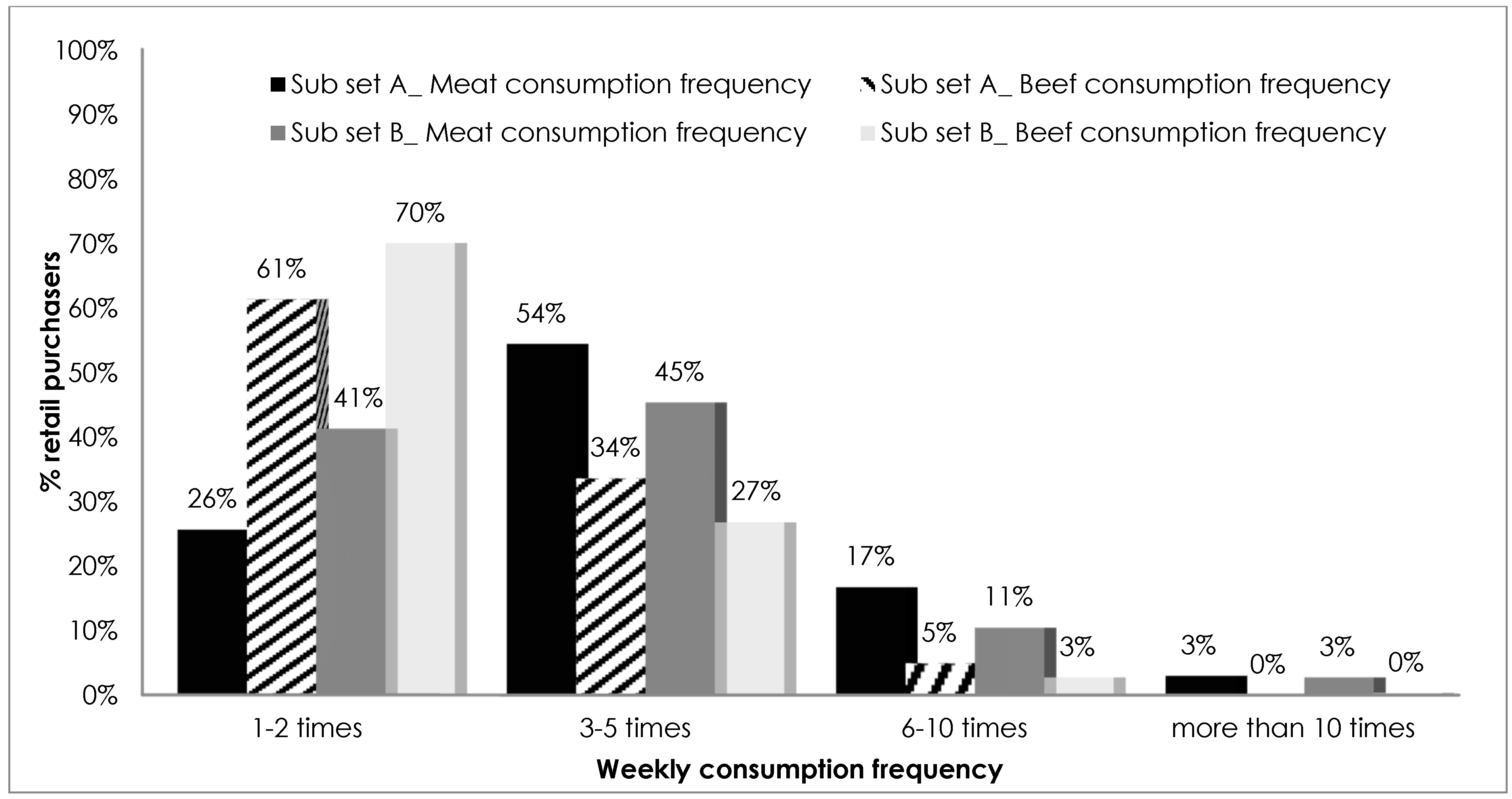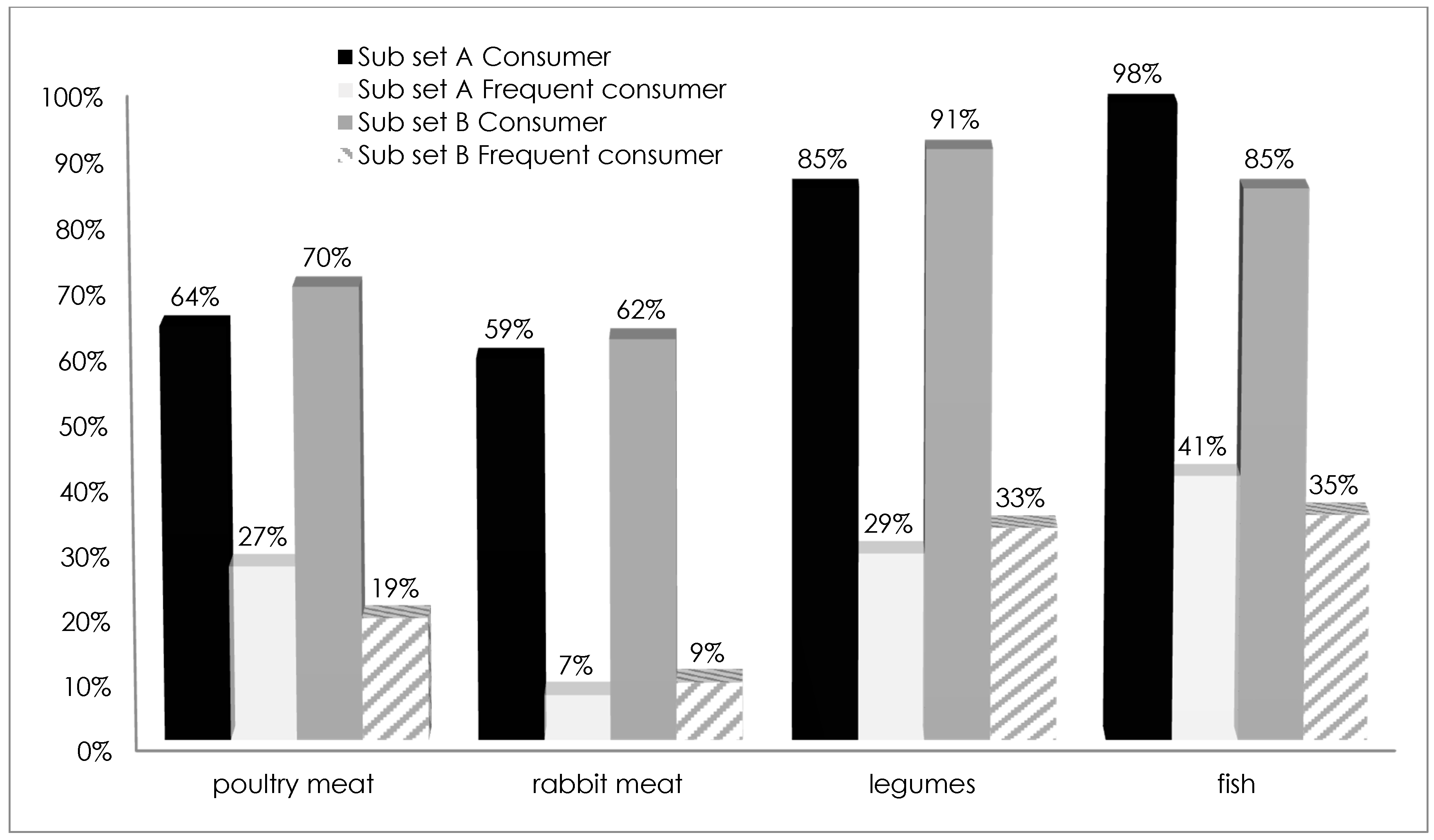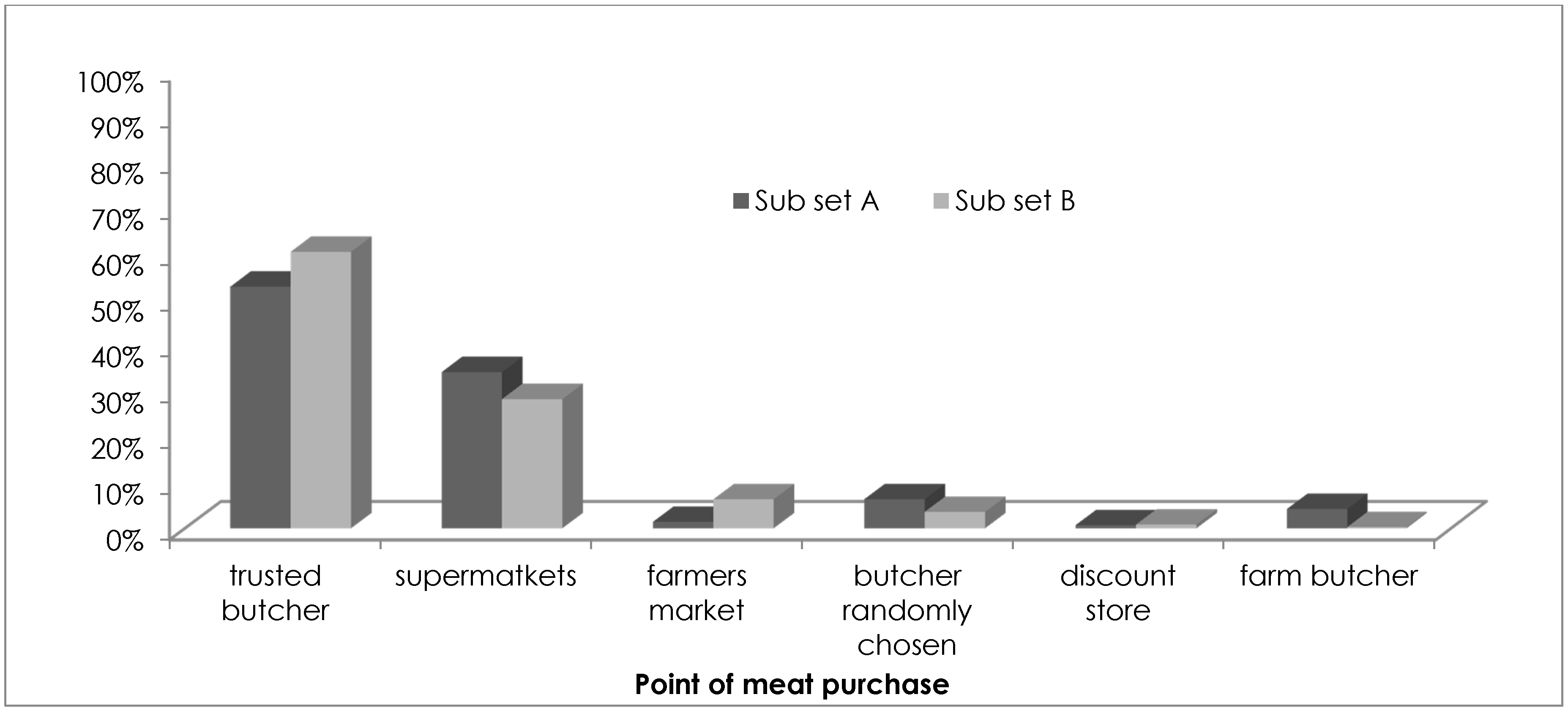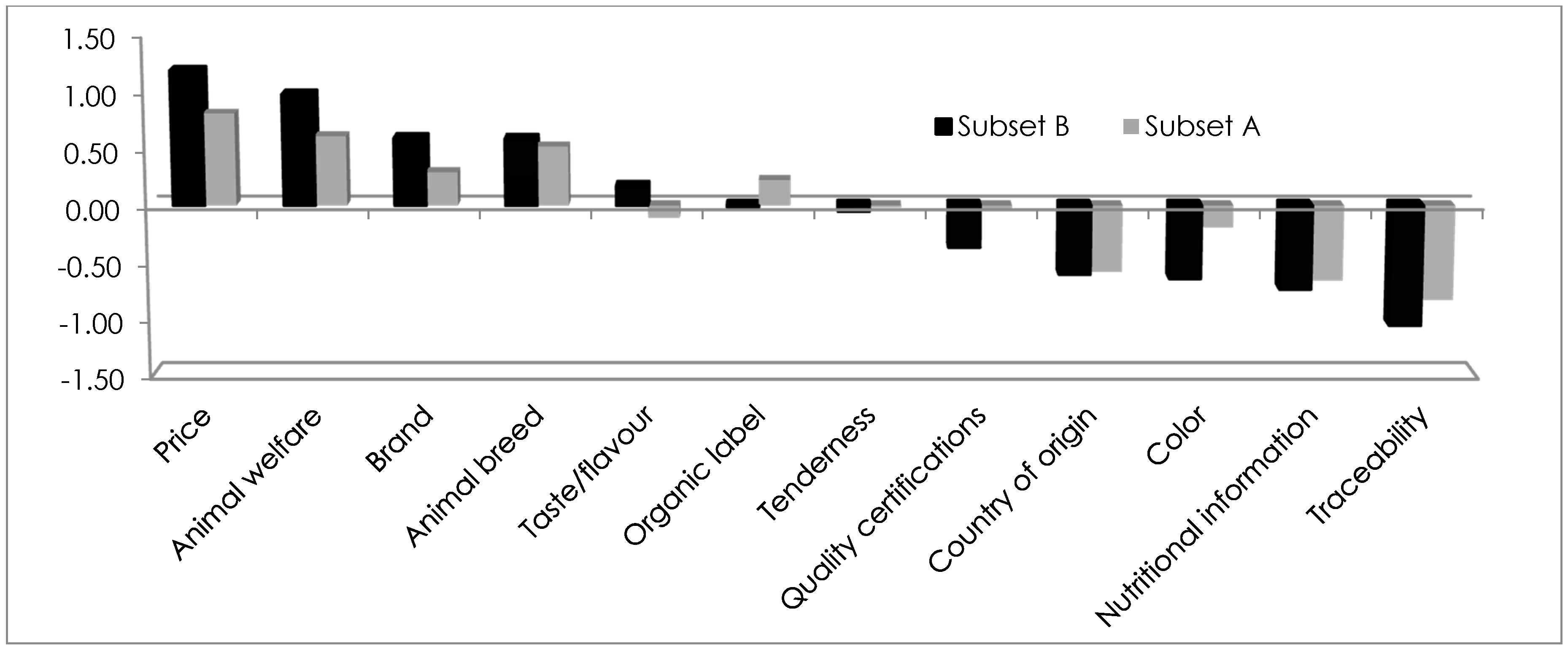Household Behavior with Respect to Meat Consumption: Differences between Households with and without Children
Abstract
:1. Introduction
2. Materials and Methods
2.1. Data Collection
2.2. Questionnaire Set-Up
2.3. Best-Worst Methodology
3. Results
Best-Worst Analysis
4. Discussion
5. Conclusions
Acknowledgments
Author Contributions
Conflicts of Interest
Appendix A. Questionnaire
- 1.
- Gender □ Man □ Woman. Age: ________
- 2.
- Educational status:
| □ Primary school | □ Lower secondary school | □ Upper secondary school | □ Bachelor or Master’s Degree |
- 3.
- Employment
| □ Student | □ Employed | □ Entrepreneur |
| □ Retired | □ Unemployed | □ Homemaker |
- 4.
- Meat weekly consumption
| □ No consumption | □ 1–2 times | □ 3–5 times | □ 6–10 times | □ More than 10 times |
- 5.
- Beef meat consumption
| □ No consumption | □ 1–2 times | □ 3–5 times | □ 6–10 times | □ More than 10 times |
- 6.
- Different protein sources consumption frequency
| • Poultry meat | □ never | □ sometimes | □ often |
| • Rabbit meat | □ never | □ sometimes | □ often |
| • Legumes | □ never | □ sometimes | □ often |
| • Fish | □ never | □ sometimes | □ often |
| MOST/BEST (Only One Answer) | Attribute | LEAST/WORST (Only One Answer) |
| ⚪ | Traceability | ⚪ |
| ⚪ | Price | ⚪ |
| ⚪ | Brand | ⚪ |
| ⚪ | Animal breed | ⚪ |
References
- Baourakis, G.; Kalaitzis, P.; Mattas, K. Food Chains: Quality, Safety and Efficiency in a Challenging World; Routledge: Abingdon-on-Thames, UK, 2012. [Google Scholar]
- Vinnari, M.; Mustonen, P.; Räsänen, P. Tracking down trends in non-meat consumption in Finnish households, 1966–2006. Br. Food J. 2010, 112, 836–852. [Google Scholar] [CrossRef]
- Grunert, K.G.; Bredahl, L.; Brunsø, K. Consumer perception of meat quality and implications for product development in the meat sector—A review. Meat Sci. 2004, 66, 259–272. [Google Scholar] [CrossRef]
- Bernués, A.; Olaizola, A.; Corcoran, K. Labelling information demanded by European consumers and relationships with purchasing motives, quality and safety of meat. Meat Sci. 2003, 65, 1095–1106. [Google Scholar] [CrossRef]
- Ehmke, M.T. International differences in consumer preferences for food country-of-origin: A meta-analysis. In Proceedings of the American Agricultural Economics Association Meeting, Long Beach, CA, USA, 23–26 July 2006. [Google Scholar]
- Verbeke, W.; Ward, R.W. Consumer interest in information cues denoting quality, traceability and origin: An application of ordered probit models to beef labels. Food Qual. Preference 2006, 17, 453–467. [Google Scholar] [CrossRef]
- Becker, T. Consumer perception of fresh meat quality: A framework for analysis. Br. Food J. 2000, 102, 158–176. [Google Scholar] [CrossRef]
- Curtis, K.R.; Cowee, M.W.; Lewis, S.R.; Harris, T.R. Consumer Preferences for Meat Attributes; Internal Publication of University of Nevada: Reno, NV, USA, 2006. [Google Scholar]
- Knight, S.; Barnett, L. Justifying attitudes towards animal use: A qualitative study of people’s views and beliefs. Anthrozoos 2008, 21, 31–42. [Google Scholar] [CrossRef]
- Toma, L.; Stott, A.W.; Revoredo-Giha, C.; Kupiec-Teahan, B. Consumers and animal welfare. A comparison between European Union countries. Appetite 2012, 58, 597–607. [Google Scholar] [CrossRef] [PubMed]
- Morgan, J.; Taylor, A.; Fewtrell, M. Meat consumption is positively associated with psychomotor outcome in children up to 24 months of age. J. Pediatr. Gastroenterol. Nutr. 2004, 39, 493–498. [Google Scholar] [CrossRef] [PubMed]
- Wu, T.C.; Chen, P.H. Health consequences of nutrition in childhood and early infancy. Pediatr. Neonatol. 2009, 50, 135–142. [Google Scholar] [CrossRef]
- Fanjiang, G.; Kleinman, R.E. Nutrition and performance in children. Curr. Opin. Clin. Nutr. Metab. Care 2007, 10, 342–347. [Google Scholar] [CrossRef] [PubMed]
- Gillman, M.W.; Rifas-Shiman, S.L.; Frazier, A.L.; Rockett, H.R.; Camargo, C.A., Jr.; Field, A.E.; Colditz, G.A. Family dinner and diet quality among older children and adolescents. Arch. Fam. Med. 2000, 9, 235–240. [Google Scholar] [CrossRef] [PubMed]
- Lichtenstein, A.H.; Appel, L.J.; Brands, M.; Carnethon, M.; Daniels, S.; Franch, H.A.; Franklin, B.; Kris-Etherton, P.; Harris, W.S.; Karanja, N.; et al. Diet and lifestyle recommendations revision 2006. Circulation 2006, 114, 82–96. [Google Scholar] [CrossRef] [PubMed]
- Guenther, P.M.; Jensen, H.H.; Batres-Marquez, S.P.; Chen, C.F. Sociodemographic, knowledge, and attitudinal factors related to meat consumption in the United States. J. Am. Diet. Assoc. 2005, 105, 1266–1274. [Google Scholar] [CrossRef] [PubMed]
- Rimal, A. Meat labels: Consumer attitude and meat consumption pattern. Int. J. Consum. Stud. 2005, 29, 47–54. [Google Scholar] [CrossRef]
- Finn, A.; Louviere, J.J. Determining the Appropriate Response to Evidence of Public Concern: The Case of Food Safety. J. Public Policy Mark. 1992, 11, 12–25. [Google Scholar]
- Marley, A.A.; Louviere, J.J. Some Probabilistic Models of Best, Worst and Best-Worst Choices. J. Math. Psychol. 2005, 49, 464–480. [Google Scholar] [CrossRef]
- Girgenti, V.; Massaglia, S.; Mosso, A.; Peano, C.; Brun, F. Exploring Perceptions of Raspberries and Blueberries by Italian Consumers. Sustainability 2016, 8, 1027. [Google Scholar] [CrossRef]
- Cohen, S.H.; Markowitz, P. Renewing Market Segmentation: Some New Tools to Correct Old Segmentation; Sawtooth Software Inc.: Orem, UT, USA, 2002; pp. 1–17. [Google Scholar]
- Cohen, S.H.; Orme, B. What’s Your Preferences? Mark. Res. 2004, 16, 32–37. [Google Scholar]
- Orme, B. S.S.I Web V.8.1, Sawthoot Software; IBM Corporation: Armonk, NY, USA, 2012; pp. 558–561, 571–572. [Google Scholar]
- De-Magistris, T.; Gracia, A.; Albisu, L.M. Wine consumers’ preferences in Spain: An analysis using the best-worst scaling approach. Span. J. Agric. Res. 2014, 12, 529–541. [Google Scholar] [CrossRef]
- Gilbert, L. The consumer market for functional foods. J. Nutraceuticals Funct. Med. Foods 1997, 1, 5–21. [Google Scholar] [CrossRef]
- Verbeke, W. Consumer acceptance of functional foods: Socio-demographic, cognitive and attitudinal determinants. Food Qual. Preference 2005, 16, 45–57. [Google Scholar] [CrossRef]
- Verbeke, W.; Ward, R.W.; Viaene, J. Probit analysis of fresh meat consumption in Belgium: Exploring BSE and television communication impact. Agribusiness 2000, 16, 215–234. [Google Scholar] [CrossRef]
- Verbeke, W.; Vackier, I. Profile and effects of consumer involvement in fresh meat. Meat Sci. 2004, 67, 159–168. [Google Scholar] [CrossRef] [PubMed]
- Colombino, A.; Giaccaria, P. Breed contra Beef. In Political Ecologies of Meat; Routledge, Taylor & Francis Group: New York, NY, USA, 2015; p. 161. [Google Scholar]
- Davidson, A.; Schröder, M.J.A.; Bower, J.A. The importance of origin as a quality attribute for beef: Results from a Scottish consumer survey. Int. J. Consum. Stud. 2003, 27, 91–98. [Google Scholar] [CrossRef]
- Lagerkvist, C.J. Consumer preferences for food labelling attributes: Comparing direct ranking and best-worst scaling for measurement of attribute importance, preference intensity and attribute dominance. Food Qual. Preference 2013, 29, 77–88. [Google Scholar] [CrossRef]
- Verbeke, W.; Pérez-Cueto, F.J.A.; de Barcellos, M.D.; Krystallis, A.; Grunert, K.G. European citizen and consumer attitudes and preferences regarding beef and pork. Meat Sci. 2010, 84, 284–292. [Google Scholar] [CrossRef] [PubMed]
- Schnettler, B.; Vidal, R.; Silva, R.; Vallejos, L.; Sepúlveda, N. Consumer willingness to pay for beef meat in a developing country: The effect of information regarding country of origin, price and animal handling prior to slaughter. Food Qual. Preference 2009, 20, 156–165. [Google Scholar] [CrossRef]
- Special Eurobarometer, European Commission. Attitudes of EU Citizens toward Animal Welfare; European Commission: Brussels-Capital Region, Belgium, 2007; p. 82. [Google Scholar]
- Borra, D.; Tarantola, M. Il Consumatore Europeo e il Benessere Animale. Indagine di Slow Food Sui Consumi e le Abitudini di Acquisto Della Carne in Funzione Della Percezione Dell’animal Welfare; Franco Angeli Editore: Milano, Italy, 2015. [Google Scholar]




| Meat Qualitative Attributes | ||
|---|---|---|
| Price | Brand | Animal welfare |
| Country of origin | Color | Taste/flavor |
| Traceability | Nutritional information | Tenderness |
| Animal breed | Organic label | Quality certifications |
| Most Influential | Attributes | Least Influential |
|---|---|---|
| ⚪ | Tenderness | ⚪ |
| ⚪ | Certifications | ⚪ |
| ⚪ | Brand | ⚪ |
| ⚪ | Animal welfare | ⚪ |
| Subset A | Subset B | ||
|---|---|---|---|
| Gender | Women | 68% | 58% |
| Men | 32% | 42% | |
| Age | ≤30 years old | 2% | 33% |
| Between 31 and 45 years old | 66% | 36% | |
| Between 46 and 55 years old | 29% | 23% | |
| >55 years old | 3% | 8% | |
| Education Level | Primary School | 0% | 10% |
| Lower Secondary School | 10% | 37% | |
| Upper Secondary School | 63% | 9% | |
| Master’s degree | 27% | 44% | |
| Employment Status | Homemaker | 20% | 9% |
| Unemployed | 6% | 2% | |
| Employed | 12% | 40% | |
| Entrepreneur | 60% | 14% | |
| Retired | 0% | 31% | |
| Student | 2% | 5% |
| Households with Children (A) | Households without Children (B) | ||||||
|---|---|---|---|---|---|---|---|
| Attributes | Cluster A1 | Cluster A2 | Cluster A3 | Cluster B1 | Cluster B2 | Cluster B3 | Cluster B4 |
| 30.1% | 44.5% | 25.5% | 23.4% | 32.5% | 31.2% | 12.9% | |
| Traceability | 7.59 | 2.48 | 2.80 | 3.60 | 7.66 | 2.05 | 8.03 |
| Price | 7.19 | 19.87 | 11.68 | 9.35 | 9.75 | 19.52 | 6.17 |
| Brand | 12.04 | 10.21 | 9.93 | 9.86 | 7.89 | 11.00 | 7.00 |
| Animal breed | 8.54 | 10.74 | 12.36 | 13.27 | 6.99 | 13.40 | 9.18 |
| Color | 4.40 | 2.87 | 12.78 | 11.05 | 3.76 | 4.79 | 18.00 |
| Animal welfare | 11.77 | 15.09 | 10.45 | 7.08 | 12.88 | 14.03 | 7.02 |
| Country of origin | 10.73 | 4.81 | 1.99 | 3.46 | 7.16 | 4.26 | 7.58 |
| Organic label | 4.49 | 10.12 | 7.74 | 7.84 | 7.65 | 10.36 | 11.10 |
| Nutritional information | 6.60 | 1.84 | 12.43 | 16.87 | 4.90 | 2.02 | 2.65 |
| Tenderness | 8.26 | 9.50 | 4.04 | 4.41 | 10.54 | 8.40 | 6.38 |
| Quality certifications | 8.01 | 4.41 | 6.87 | 8.43 | 7.73 | 5.13 | 11.75 |
| Taste/flavour | 10.38 | 8.08 | 6.93 | 4.78 | 13.08 | 5.04 | 5.13 |
 Most relevant attribute;
Most relevant attribute;  Second most relevant attribute;
Second most relevant attribute;  Least relevant attribute.
Least relevant attribute.© 2017 by the authors. Licensee MDPI, Basel, Switzerland. This article is an open access article distributed under the terms and conditions of the Creative Commons Attribution (CC BY) license (http://creativecommons.org/licenses/by/4.0/).
Share and Cite
Merlino, V.M.; Borra, D.; Verduna, T.; Massaglia, S. Household Behavior with Respect to Meat Consumption: Differences between Households with and without Children. Vet. Sci. 2017, 4, 53. https://doi.org/10.3390/vetsci4040053
Merlino VM, Borra D, Verduna T, Massaglia S. Household Behavior with Respect to Meat Consumption: Differences between Households with and without Children. Veterinary Sciences. 2017; 4(4):53. https://doi.org/10.3390/vetsci4040053
Chicago/Turabian StyleMerlino, Valentina Maria, Danielle Borra, Tibor Verduna, and Stefano Massaglia. 2017. "Household Behavior with Respect to Meat Consumption: Differences between Households with and without Children" Veterinary Sciences 4, no. 4: 53. https://doi.org/10.3390/vetsci4040053






